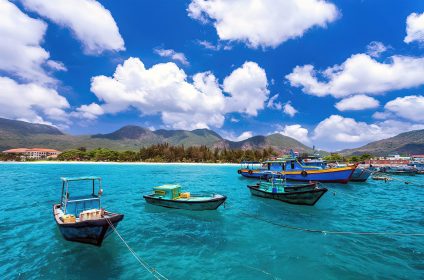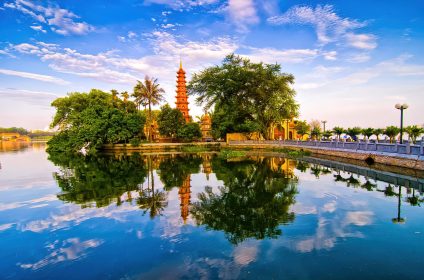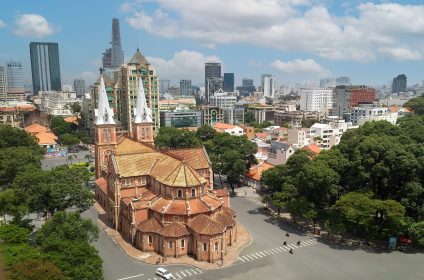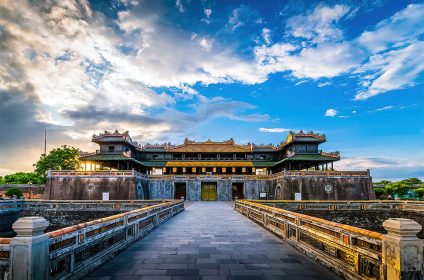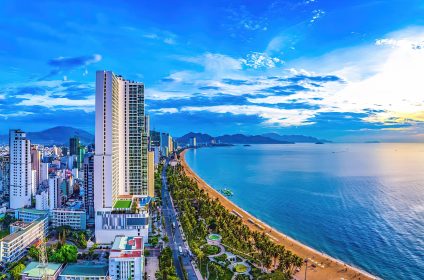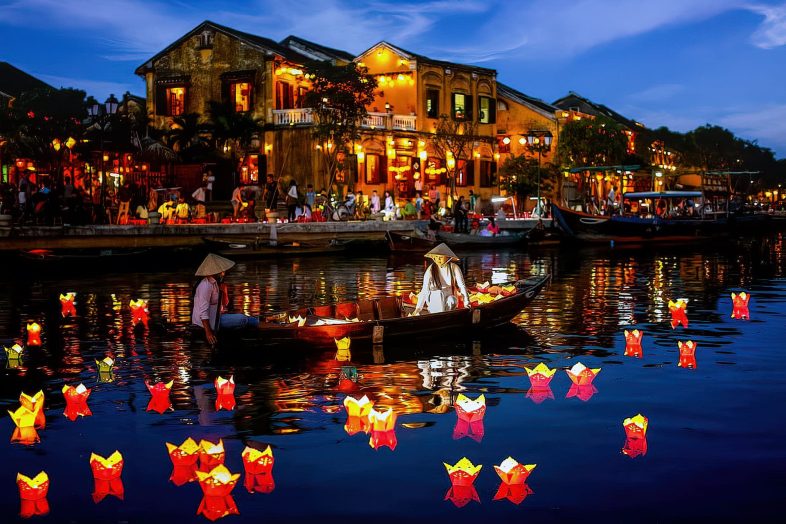
Hoi An
Hoi An, alternatively called Fai-Fo and Faifoo was a city in Quang Nam Province. It had an approximate population of 120,000 residents since it obtained the UNESCO World Heritage Site label in 1999. In addition to the Cu Lao Cham archipelago, it was declared part of the Cu Lao Cham-Hoi An Biosphere Reserve in 2009.
Old Town Hoi An also called The Ancient Town is considered as a remarkably well-preserved example of a Southeast Asian commercial port town which flourished during the period from the 15th to 19th century; its buildings and streets reflected a confluence of local and foreign influences. The Old City boasts one prominently visible ancient Japanese Covered Bridge that dates back to the sixteenth-century.
The place is none other than Hoi An Ancient Town, certified by UNESCO as one among Vietnam’s attractive cities with ancient characteristics. Located on Thu Bon Riverbank, this intact village epitomizes great diversity or synthesis between indigenous and alien cultures that have blended into an extraordinary cultural heritage site. Between the 15th to 19th centuries, Hoi An was highly important as an international trading port attracting many visitors from all over the world.
Currently, Hoi An keeps its renown. This peaceful town is dotted with holy temples; here are some enchanting surroundings lit up by multi-colored lanterns as well as yellow walls; there is also a well-preserved area full of historical structures. The original culture identity has made this place so special for every person across any corner of the Earth. People who come to Hoi An can further go to other beautiful places in Central Vietnam like Cu Lao Cham Islands or Cua Dai Beaches among others.
Weather & Climate In Hoi An
Hoi An has an average annual temperature of 29 degrees Celsius and two seasons namely wet and dry. The months between June and August are the warmest with day time temperatures hitting 38 °C. The coldest months fall between November and January, with average temperatures of 20°C. From September to January, Hoi An experiences rainy season characterized by heavy downpour that may lead to floods thus hampering tourism.
From February to May, it is the city’s dry season with mild weather having moderate temperatures as well as low humidity levels. Only calm pleasant weather can be found in May/June until the end of August with smooth waves in the south wind. The rest of the year involves alternating rainy spells followed by cold ones and heat then becomes coolness. During the peak domestic tourism season that falls between May to the end of August only Cù lao Chàm islands can be visited.
Tourism In Hoi An
UNESCO designated the old town as a World Heritage Site in 1999 due to it being intact example of Southeast Asian trading port dating from 15th to 19th centuries featuring buildings with local and global influences. The stakeholders find it difficult to safeguard the tourist attractions according to the 2008 UNESCO Impact Report on Hoi An.
Moreover, with the increasing number of tourists visiting Hoi An there has been a proliferation of activities enabling visitors’ access outside ancient area for motorcycling, bicycling, kayaking, or motorboating. Today after passing through this river first time over five hundred years ago by António de Faria, thu ban river still plays vital role in the region as an agricultural and transportation source. This has led to an increase in kayaking and motor boating activities that cater for tourists.
The historic port city possesses a local cuisine that fuses various cultural influences of East and Southeast Asia across centuries. Visitors can take part in different cookery courses in Hoi An which enable them learn how to make Cao Lầu “a local specialty dish made by braising spicy pork noodle”.
It was during the nineties when Hoi An wreck dubbed “the shipwreck”, a warship either sinking at end Fifteenth century or early sixteenth century off the coast of Cham Islands near Hoi An was discovered. During three years (1996-1999), excavation teams including Vietnamese National Salvage Corporation together with Marine Archaeology Research Division (Oxford University) managed to recover nearly three hundred thousand items.
Meanwhile, every full moon night additional attraction is ‘Hoi An Lantern Full Moon Festival’. It is a festival held to honor ancestors by throwing flowers among other things like lanterns candles fruits for prosperity and good luck.
In addition, well-heeled Asian tourists love taking selfies and posing for photos on top floor balconies at Faifo Café.
In 2019, Hoi An has been identified as one of Vietnam’s most important cultural tourism destinations which entails “rapid tourism growth threatens sustainability”.
Previously the Chàm Islands-Hoi An Marine Protected Area suffered from too many tourists that ended up causing damage to the eco-system.

Hoi An - Introduction
Density
Telephone code
Population
Area
License plates
Time zone
Hoi An Travel Guide
Best time to visit Hoi An
Hoi An has a tropical climate and is located in the southern Hai Van region which experiences two main seasons namely dry and wet.
From September to January it is raining. On the contrary, Hoi An’s winter has an average temperature of 20 degrees unlike the North of Vietnam (which includes Hanoi, Halong Bay and Sapa).
February to August constitutes the dry season which is marked with low rainfall as well as high temperatures. Despite this, due to its proximity to the sea, Hoi An does not get sizzling hot like other parts of Vietnam do.
To sum up, it is ideal to visit Hoi An between February and July when spring and early summer seasons brings about good weather characterized by coolness and blue skies.
How To Travel To Hoi An
Da Nang (DAD) airport is the nearest one that offers flights within Vietnam to Hanoi, Ho Chi Minh City, Nha Trang, Can Tho and Da Lat besides a few international destinations such as Bangkok, Chiang Mai, Singapore, Siem Reap (Angkor Wat), Seoul, Tokyo, Hong Kong and charter flights to China.
It costs approximately $22 by a metered taxi from Da Nang airport to Hoi An. Instead of using a meter on this occasion it is cheaper to bargain for a fixed price. They are available at $5 per person; you should get out of the airport first since there are no minibus from there but you have to go first downtown). It takes around 45 minutes.
There is no railway station in Hoi An. The closest one is Da Nang (+84 511 3750666), which sees multiple trains coming every day from Hanoi, Ho Chi Minh City, Hue; Nha Trang etc. Most travel agencies and hotels sell train tickets as well as some online retailers.
How To Travel Around Hoi An
You’ll be walking almost all the time because Hoi An’s center is so small and pedestrian-friendly. Even when motorcycles aren’t permitted in the town center (8 a.m. to 11 a.m., 1:30 p.m. to 4:30 p.m.), keep an eye out for motorized kamikazes, even in the narrowest alleys.
On the 14th and 15th of every lunar month, when bikes are barred altogether, city authorities clear out traffic and put on numerous events throughout town on several evenings; look for traditional games like bai choi, trong quan and dap nieu.
Taxis can be found on Le Loi St in the center or over the river in An Hoi; or by phone request. When it’s busy taxis may refuse to take you from town to your hotel if it’s too close, preferring to charge you more instead. Although it might cost more money scheduling a shuttle through your hotel might be better.
Attractions & Things To See In Hoi An
In Hoi An, the Japanese Bridge, which also bears the name ‘Chua Cau’ in Vietnamese, has perennially been an emblem of a still sea-port city. Its ethereal curves and Zen-like design have made it so famous.
The legend tells us that this structure was put up to protect against Mamazu – a calamity-causing monster who is believed to have his head located in India, tail in Japan and back in Vietnam.
But really it had been set up by the Japanese traders in 1593 as a means of crossing from their side to Chinese quarter across the small stream; even today it remains a spectacular attraction and powerful symbol of the Japanese presence in Vietnam.
Located at the Old Quarter of Hoi An, this small bridge which measures nearly 20 meters joins Nguyen Thi Minh Khai Street with Tran Phu Street offering views over Thu Bon River’s calm water.
Activities & Things to do in Hoi An
There are different dive spots near Cham islands in Hoi An. The nearby shore is rich in coral reef and tropical fish, which gives one a good opportunity for snorkeling and scuba diving.
A couple of shops that deal with such things are located within the town. However, there are two which stand out among them; Blue Coral Diving and Cham Island Diving Center.
Hoi An’s diving season is not all year round as compared to some other places like Phuket. It best time to go diving here would be between March and September. When you want the most perfect weather conditions so that you can see the beauty of underwater world, June through August will work well.
In other months, extreme weather conditions occur because of seasonal storms making snorkeling and diving impossible at this coastline. Moreover majority of these diveshops close from October up to February as earlier mentioned.
Food & Restaurants in Hoi An
Cao lau is a regional dish with rice noodles, meat, greens, bean sprouts, and herbs. It’s served with a small amount of liquid.
The broth water comes from the Ba Le Well, built by the Chams in the 10th century.
Other local specialties are banh bao banh vac, hoanh thanh, com ga (chicken rice), bánh xèo, sweet corn soup, baby clam salad.
Additionally, Mi Quang Noodles and Banh Bao Banh Vac are popular dishes there.
Ớt Tương Triều Phát is a local chili sauce that many Vietnamese are familiar with.
In general, Hoi An’s cuisine is both affordable and delicious even among rich Vietnamese people.
Shopping in Hoi An
Hoi An became a World Heritage Site on December 4, 1999. This ancient town of Vietnam that was once a bustling trading port has become a real museum for everyone regardless of where they come from; and now it is surrounded by beautiful countryside which is both romantic and humanly appealing. So as you move away you will be able to remember how the moss-strewn houses you passed, the smiling Vietnamese gentlemen you saw or even the little souvenirs remind you Hoi An forever.
First of all, silk-made artifacts are likely to remind us about Hoi An. These could include home accessories such as lampshades, wall hangings and in addition garments like clothes, bags, purses among many other numerous things. These include Thai silk and Ha Dong silk which are the finest quality grades of silk used here. For that reason then Hoi An can be said to be the silk Mecca of Vietnam just as much as she used to be an important station along the Silk Road.
Nightlife in Hoi An
In Hoi An, the nightlife often appears tranquil as there is a focus on the old town’s pedestrian walkways. A leisurely evening out can be enjoyed at no cost by walking along Hoai River that is calm and lit up with multicolored lanterns in addition to visiting the night market. In addition, visitors frequently dine out at quirky bistros or laid-back wine bars while taking their sips and enjoying musical performances. Most of the hippest nightlife places offer snacks so it is just easy to grab something quickly.
At nighttime, there are many bars near the river you could visit. Beers cost around 30,000 dong. There is a range of cocktails from 20,000 to 50,000 dong. Some bar food is available such as prawn crackers fried which go for about 15,000 dong per plate . Just walk into any pub and sit down anywhere. However , Hoi An has few options when it comes to nightlife and does not qualify for partying spot.
Stay Safe & Healthy in Hoi An
Hoi An is a place prone to flooding in November, and for those who want to come during one of their floods, it is advisable that they make early bookings.
However, even though the press reported about guests being evacuated during the 2013 flood, business still went on as usual.
Tourists had already started moving to hotels that were higher up when some hotels next to the river got flooded.
This included four blocks uphill from the river and the hotel/restaurant district across the bridge on An Hoi peninsula which also suffered some damage due to flooding.
Somehow, it seems that this cleanup was organized well and that water levels seem slightly lower than in 2011’s storm.

